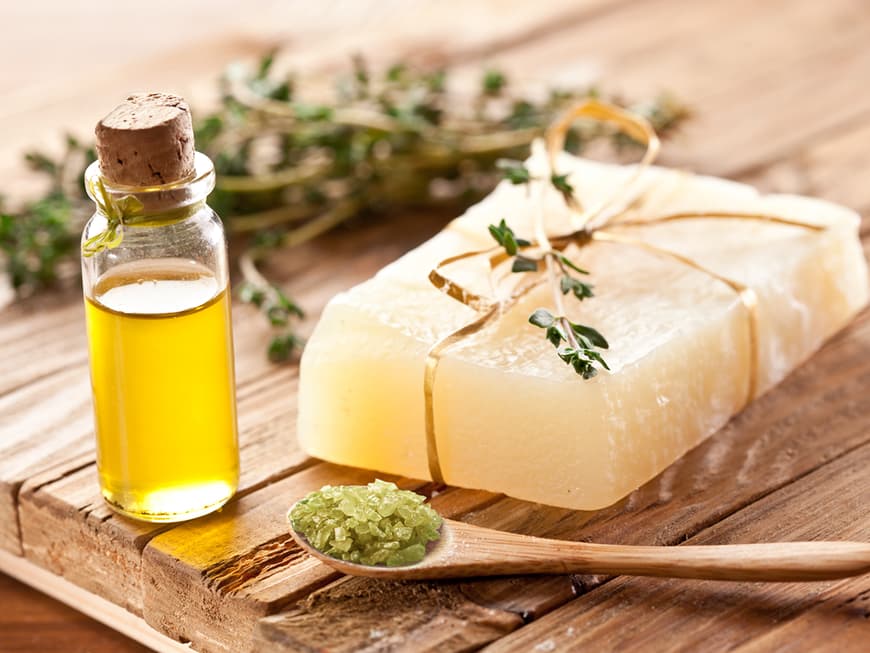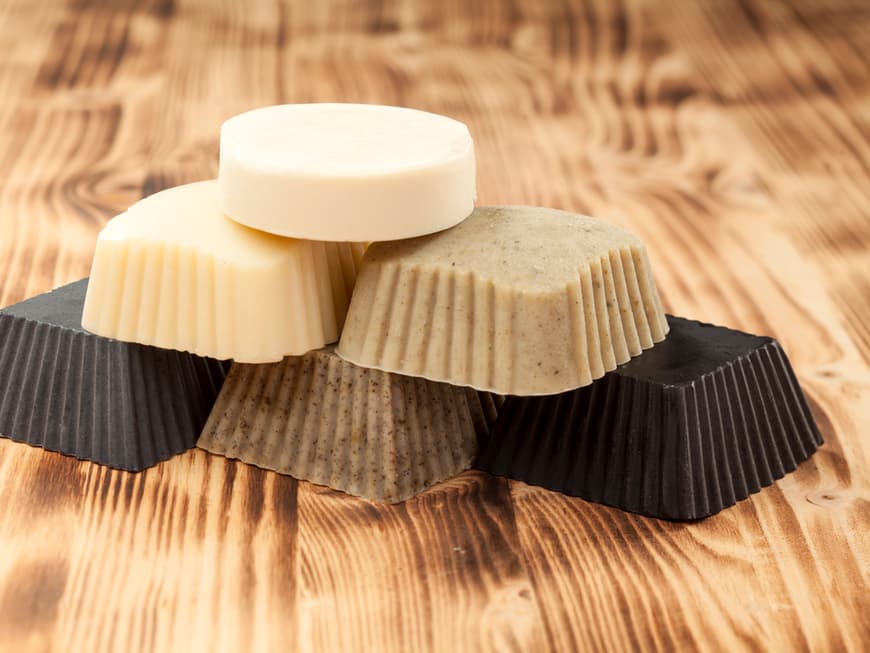The 25 recipe - the basis for soap making
For this basic soap-making recipe, you will need
- 250 g coconut oil
- 250 g palm oil
- 250 g olive oil
- 250 g rapeseed oil
- 330 g water
- 135 g sodium hydroxide (NaOH) (Please follow the safety instructions!)
Mix the NaOH with water to form a lye solution and allow the heated lye solution to cool to around 40°C. During this step, take particular care to ensure that no children are in the vicinity, as there is a high risk of injury. Now melt the solid fats in a water bath and then add the liquid fats. Cool this mixture down to 40°C or less. Make sure that the original solid fats do not change their physical state. Now carefully add the lye to the fats and stir it in thoroughly. You can use a blender or your hands for this. Essential oils can now be added to the mixture as desired and then poured into the soap mold. Insulate the soap mold well and store it in a warm place. If the soap does not set, which often happens when using individual molds, simply store the soap for another two weeks. This soap is nine percent superfatted.
Making shaving soap
The next soap is a shaving soap, which means that it foams particularly well and protects the skin from irritation. The lather comes from the white clay (kaolin).
The recipe contains:
- 200 g coconut oil
- 160 g rice germ oil
- 150 g palm oil
- 100 g babassu oil
- 100 g olive oil
- 100 g rapeseed oil
- 100 g soybean oil
- 90 g castor oil
- 136 g sodium hydroxide (NaOH)
- 330 g water
- 5 tbsp white clay (kaolin)
- 1 tbsp activated charcoal
Prepare the lye as in the 25 recipe, observing all safety instructions for handling NaOH, and then melt the solid fats in a water bath. When all the solid fats have melted, stop the heat and add the liquid oils. When the mixture has cooled to around 40°C, add the lye to the fats through a narrow-meshed sieve. Then mix everything well with a plastic spoon or a hand blender. The soap glue should not be too thick. It is also possible to add a fragrance here. Now add the white clay and activated charcoal and stir again before pouring the soap into molds. To create patterns in your soap, you can add the activated charcoal (prevents the loss of oils when the soap is washed off the skin) to only one half of the previously created mixture. You can then add soap from both halves of the mixture alternately to the mold. The soap must now rest for at least 24 hours. This soap has a superfatting content of nine percent.
Making anti-ageing and anti-acne facial soap
The most important ingredient in this soap is tamanu oil, which helps with blemished skin as well as slowing down the skin's ageing process. The additional use of various essential oils also has a disinfecting, cooling and soothing effect on the skin.
To make soap you will need
- 250 g babassu oil
- 250 g olive oil
- 100 g resicum oil
- 200 g water
- 89 g sodium hydroxide (NaOH)
- 48 g tamanu oil
- 1 tbsp activated charcoal
- 20 g lavender oil
- 10 g peppermint oil
- 5 g eucalyptus oil
If you have prepared the lye as for the previous soaps, you can now melt the babassu oil in a water bath and add the liquid oils. Now add the cooled lye to the oils through a fine-mesh sieve and puree the mixture. Now add the tamanu oil and the essential oils and then stir in the ground activated charcoal. Again, you can create layers and shapes if you only add the activated charcoal to a certain part of the soap. You can then pour the soap mixture into a block mold and leave it well insulated for at least three days. The regreasing content in this recipe is ten percent.
To make an exfoliating soap, simply add 50 percent coarse sea salt to any soap recipe before pouring the soap into the mold and stir it in briefly (and carefully) to distribute it better.
You might also be interested in this:
Make your own hair treatment: The best recipes and tips
Make your own hand cream: Recipe ideas with natural ingredients
Eco-friendly cleaners: Make your own cleaning products
DIY bath salts: gift idea with a personal touch
DIY gift idea: bath bombs for perfect relaxation


